How to Wash a Car at Home Like a Pro—Inside and Out
An at-home car wash can help you save money and maintain the look of your vehicle.
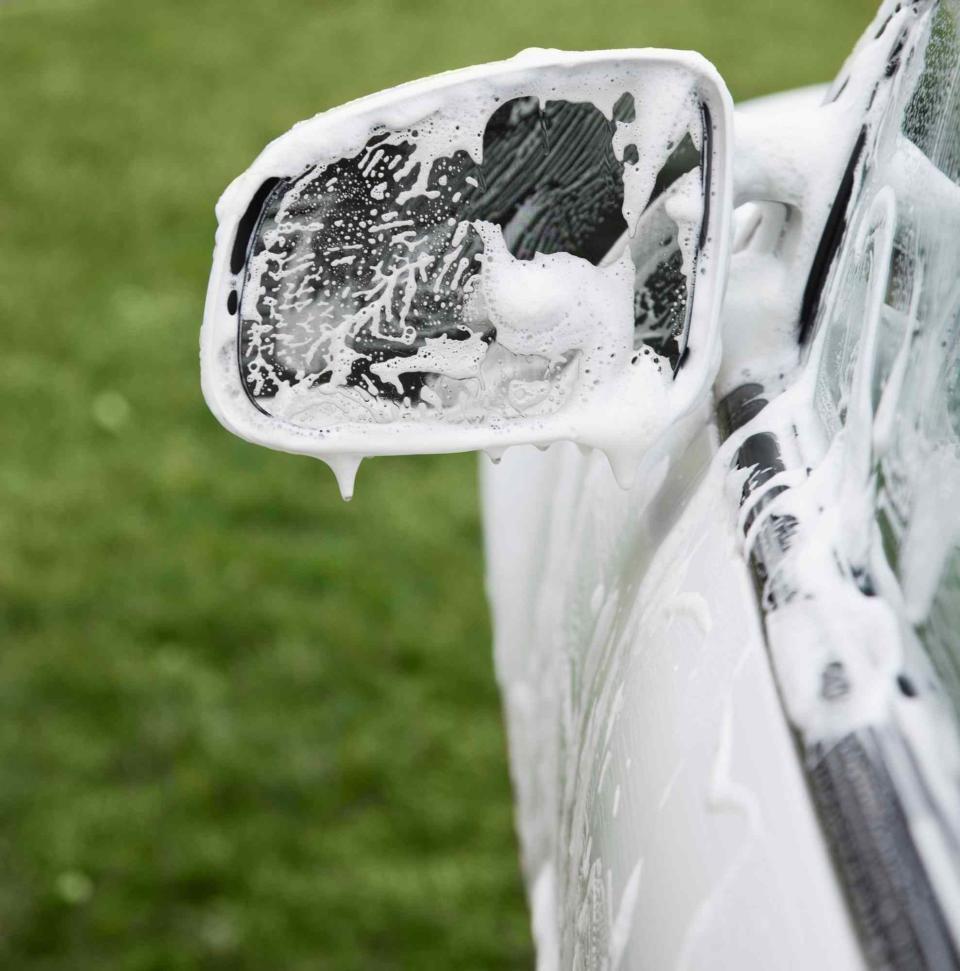
Duplicating a car wash at home can help you save money and time—and, it doesn't have to be a Herculean task that you put off...again. Yes, it's a household chore, but once you learn how to wash a car, inside and out, you'll think twice about shelling out cash for someone else to clean it. Use our step-by-step guide to wash, dry, and vacuum your car for an all-around squeaky-clean vehicle—tires included.
Before You Get Started Washing Your Car
With a little planning and organization, your home car wash will be more successful. Keep these things in mind before washing your car.
Find the shade. Park in a shaded spot before washing your car. Washing it in the sun will make it dry faster, possibly leaving soap scum and patchy spots on the car's surface. (At best this leaves your car looking unwashed. At worst it can damage your car's paint job.)
Consider parking on the grass. When washing your car at home, the soapy water and dirt that's washed off the car will likely run into a storm drain, which can lower the community's water quality. If able, park your car on grass, gravel, or another surface that will absorb the water. (The downside is that non-eco-friendly products can damage your lawn and you may end up with muddy areas that could get your tires and wheels dirty.)
Prepare to get soaked. You'll likely get plenty of water and soap on you as you wash your car, especially if there's any wind. Put on swimwear or other moisture-wicking clothing. And be sure to wear flip-flops that can get wet.
Avoid household cleaners. Using dish soap and other household cleaners or chemicals on your car can damage the paint. It's best to purchase car-safe cleaning products.
Tips
If you don't have a shady spot for washing your car at home, wash it on an overcast, cloudy day for less sunlight.
What You Need:
Supplies
Garbage bag
Auto-friendly interior cleaner (for leather, vinyl, and plastic)
Foam glass cleaner
Car-specific soap
Car wax (optional)
Headlight renewal or restoration kit (optional)
Tools
Wet-dry vacuum with a blower feature
Old, clean toothbrush
Small bowl
Water hose
Two 2-gallon buckets
Two car-wash mitts or sponges
Wheel brush (optional)
Chamois or cotton cloth
How to Wash a Car at Home
When done efficiently, washing your car at home takes less time and yields better results than using a retail car wash. Follow these steps to get the job done quickly and effectively.
Step 1: Tidy Up the Interior
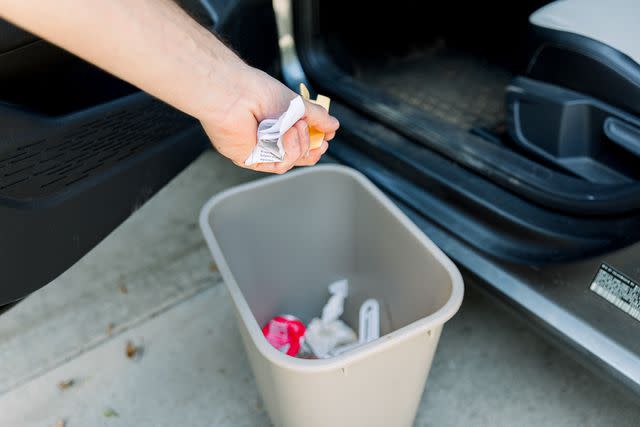
The Spruce / Ana Cadena
Remove items that don't belong in the car, and dispose of trash. Check the console, underneath seats, between armrests, in pockets, etc. to thoroughly clean the car's interior and collect long-lost treasures.
Step 2: Vacuum Floor Mats and Blow the Interior
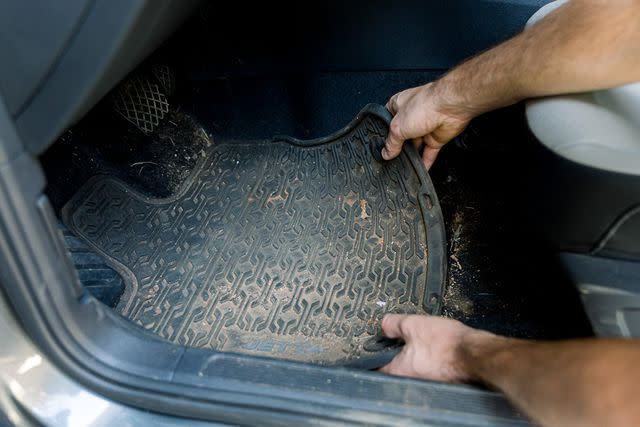
The Spruce / Ana Cadena
Remove all floor mats from the car.
Slap the mats together to remove loose dirt.
Lay them on the driveway, then vacuum them using a wet-dry vacuum with a blower.
Blow debris from the spaces between each seat and the center console with the vacuum hose connected to the exhaust port.
Then, return the hose to its original spot.
Step 3: Dust Cracks and Crevices
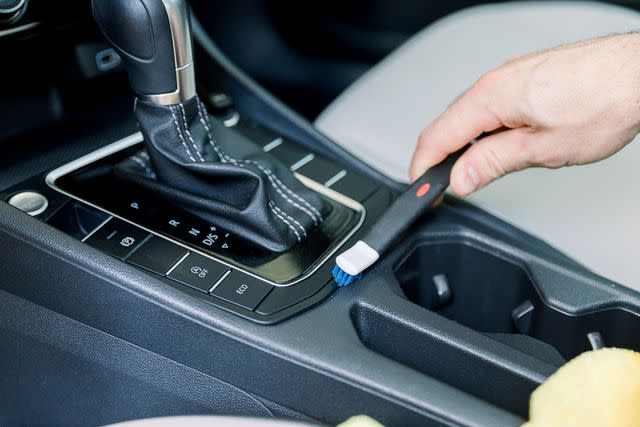
The Spruce / Ana Cadena
Rub a clean toothbrush along the dashboard and door panels to unearth debris and dust these small areas. Then, use the vacuum hose to suck up the waste.
Step 4: Vacuum the Floor and Upholstery
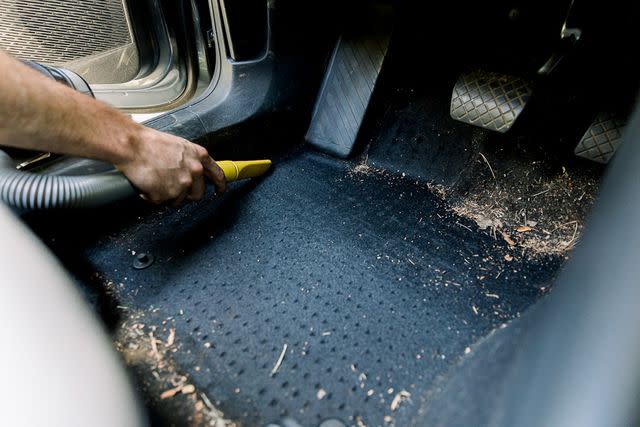
The Spruce / Ana Cadena
With the front car seats moved all the way forward, vacuum the area under them from the backseat.
While sitting in the back, vacuum the back floor.
Move the front seats back and vacuum the floor in front. Be sure to vacuum both the passenger and driver's side of the car.
Finally, recline the seats and vacuum as far into the crevices as possible to retrieve any lingering dirt.
Step 5: Wipe Down the Dashboard
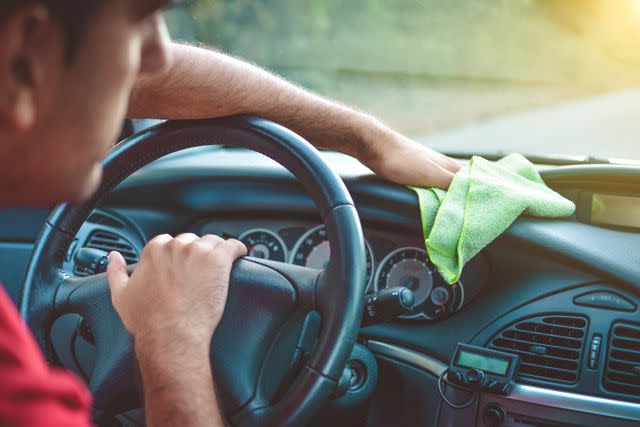
Using a microfiber cleaning cloth, wipe the dashboard. Move on to the middle console, gearshift, steering wheel, door handles, cupholders, and seats. Apply an auto-specific interior cleaner to the surfaces—skipping the seats (unless they're leather). Using a new cloth, wipe again.
Step 6: Clean Seat Belts
Dip a cotton cloth into a cup of warm water mixed with a few drops of laundry detergent. Wipe the seat belts clean.
Step 7: Wash Windows
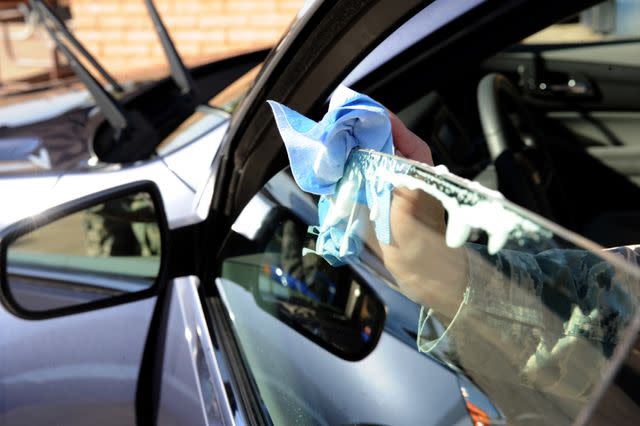
Cheyenne Morigeau / USAF
Apply a foam glass cleaner to each window like Invisible Glass ($10 for 2, amazon.com), which doesn't drip like a liquid formula.
Wipe both sides with a microfiber cloth. Work in an S-motion horizontally on the inside, and then use a vertical S-motion on the exterior. This way, you can see which side has streaks (if any) and needs another pass.
Roll down the windows and swipe the top edges.
Similarly, clean the interior of the front and back windows. And, don't forget the sunroof or moonroof, if applicable.
Step 8: Replace Floor Mats
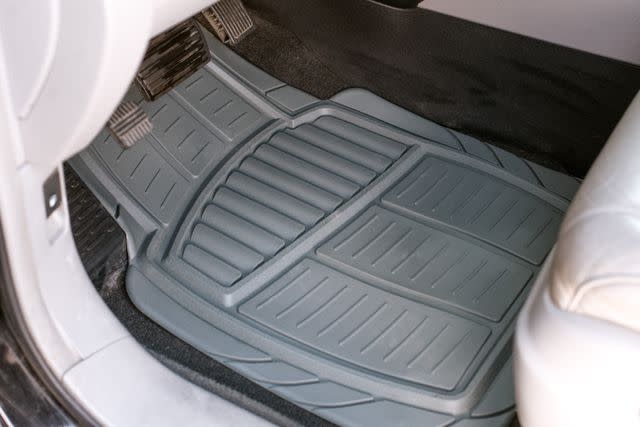
The Spruce / Sarah Lee
Replace all floor mats. Give them a shake before placing them in the car to remove any dust or dirt that may have landed on them from sitting on the driveway.
Step 9: Hose Down the Exterior
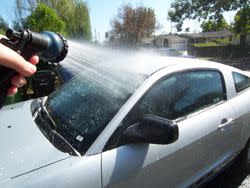
Make sure that all car doors and windows are closed. Hose down the entire car, paying special attention to the tires (and the panels behind them), where debris and brake dust collect.
Step 10: Lather and Scrub
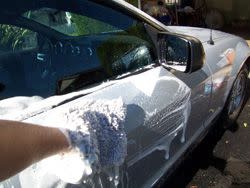
Fill two 2-gallon buckets with water. To one, add a few squirts of an auto-specific soap like Meguiar's ($4, amazon.com). Leave the other with plain, clean water.
With a car-wash mitt or a sponge, apply soapy water liberally over the exterior, rinsing the mitt periodically in the bucket of plain water to avoid scratching the finish with clinging debris.
Working from top to bottom, wash the car exterior in this order, hosing off after each area to prevent the soap from drying: roof, hood, rear, upper portion of each side, and then lower portion of each side.
Step 11: Clean Tires and Wheels
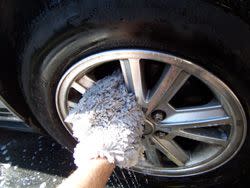
Using a second mitt or sponge, clean the tires (the rubber part) and wheels (the metal or coated alloy rims). You may need a wheel brush to reach smaller spots. You can also use an old toothbrush to clean between the wheel spokes.
Step 12: Rinse and Dry Exterior

Using the hose, thoroughly rinse the car from top to bottom to be sure all soap is rinsed off, allowing the water to drip to the floor. Working in a circular motion immediately dry the car with a chamois or cotton cloth, from high to low. This way, as the water moves down, they won't rewet areas you just dried.
Tips
Try using a leaf blower to dry your car faster, working from top to bottom to let the water drip down.
Step 13: Apply Wax (Optional)
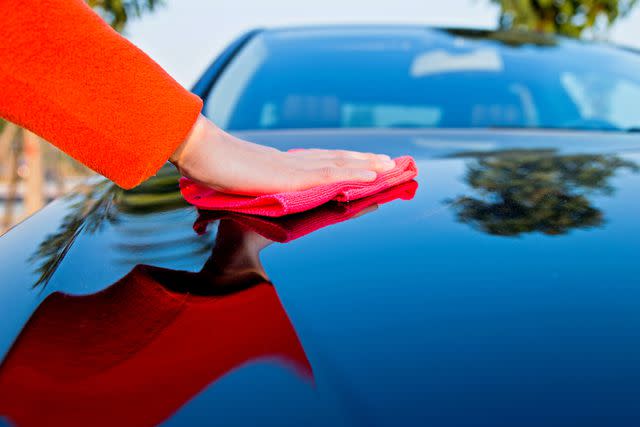
While optional, applying car wax can help protect the car's exterior. One wax coat typically lasts about three months, so you don't have to do this step every time you wash your car. When necessary, here's how to do so:
Once the car is fully dry, apply wax like To The Max Wax ($28, turtlewax.com) for a shiny, protective layer.
Use a clean, soft cloth, and follow the label's directions.
Step 14: Restore Headlights (Optional)
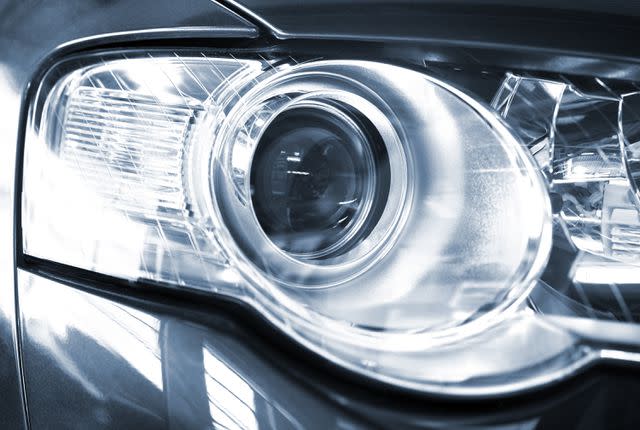
If your headlights have dulled or yellowed, you can revive them using a headlight renewal kit like 3M's Quick Headlight Renewal ($4, amazon.com) that sands and polishes the lens. Some restoration kits can cause damage to automotive paint, so follow the manufacturer's instructions, use them with care, or consult a professional.
How Often to Wash a Car
You should wash your car at home about every two weeks. Doing so will help preserve your car's paint job and prevent dirt or grime from settling in. Of course, if you drive through a particularly dirty area (mud, dusty construction site, etc.), you should wash your car right away to remove debris.
How to Keep Your Car Clean Longer
Help your car stay clean between washings and vacuum sessions with these tips.
Wash your car often. Regularly washing your car will help prevent rain spots, dust, and other streaks from setting in. It also helps make each car washing session go faster.
Wax or seal the exterior. You can apply a wax or paint sealant to protect your car from the rain and other environmental factors. Follow the product's instructions carefully and reapply when suggested.
Declutter and clean out garbage. Keep a small trash can or bag inside your car for easy collection and disposal of trash. Clean it out daily or at the very least, once a week.
Use cup holder liners. To avoid sticky cup holders from condensation and spills, purchase liners to insert in the cupholders. You can also insert silicone cupcake liners as a DIY option. Then, periodically remove and wipe clean.
Keep wipes handy. For quick cleaning of spills, use wet wipes. Be sure they're bleach-free so you don't affect the interior.
Dust off shoes. Before entering your car, knock your shoes clean against the side of the car. Removing dirt, snow, and other environmental debris, can help prevent buildup on your car floor or mats.
Clean messes when they occur. Clean up spills right away to avoid letting the stain set in. This will make it easier to remove the stain.
Removing Stains From a Car
Depending on where you live and your lifestyle, your car may acquire stubborn stains (inside and out) that require a little extra work. Here's how to remove stains from your car for a truly clean vehicle.
Remove Bug Stains
Purchase a car-friendly bug stain remover and spray it on spots or streaks where bugs may have landed (like your front bumper).
Allow the spray to sit for a few minutes. Follow the label's directions for best results.
Rub the spot clean using a soft cloth. (It may need a bit of elbow grease.)
Remove Tree Sap
If tree sap (aka tree gum) has landed on your car's exterior, you may be able to wash it off with warm, soapy water. If it's been a while and the spot has settled, use rubbing alcohol. Apply to the tree sap stain with a microfiber cloth, let it sit for 30-60 seconds, then wipe clean.
Remove Gum
From exterior: For gum stuck on your car's exterior, it's much easier to remove it if it has hardened. Try using compressed air (or an ice cube) to freeze the gum, then scrape it off with a plastic card or knife.
From interior: Gum that's unfortunately stuck on a car seat or floor can be removed with white distilled vinegar. Soak a soft cloth in vinegar, rub it onto the gum, and allow it to soak for a few minutes. The vinegar should cause the gum to ball up, making it easier to remove.
Remove Coffee Stains
It's best to take care of coffee stains on your seats or carpet as soon as they happen. However, if it's an older stain, here's how to clean it.
Apply a vinegar and soap solution. Mix one part white vinegar, two parts water, and a few drops of dish soap in a small container and apply to the stain.
Clean the stain. Scrub the stain with a sponge, soft scrubbing brush, or towel, and let the cleaning solution sit for about 20 or 30 minutes.
Rinse the spot. Blot the stain with clean water and a clean towel. Continue blotting the spot (rinsing the towel in between) until no more streaks appear on the towel.
Dry the area. Open the car windows to help the spot air-dry (if weather permits) and use a blow dryer on its lowest setting to help the spot dry faster.
Remove Food Stains
Similar to coffee stains, you'll want to clean food spills from your car ASAP for the best chance of preventing long-term stains. For more stubborn food stains, here's what to do.
Remove solid food. Clean off larger pieces of solid food using paper towels or a vacuum.
Soak up any liquids. Blot the spill to pick up as much liquid as you can. Change or rinse the cloth as you go and continue blotting until the cloth is clear.
Apply soapy water. Mix water and mild dish soap in a container and apply to the stain. (You can also purchase a car-safe upholstery cleaner designed for your car's material.)
Scrub clean. Using a circular motion, use a soft brush or sponge to clean the stain. Avoid oversaturating the spot with water.
Rinse the spot. Dip a clean microfiber cloth into clean water and blot the area to remove the soap. Repeat until all soap is gone.
Dry the area. Use a hair dryer on low to dry the spot. Open the car windows for added ventilation.
Related: 7 Car Decluttering Tips to Finally Get Your Car Clean—and Keep It That Way
For more Real Simple news, make sure to sign up for our newsletter!
Read the original article on Real Simple.

